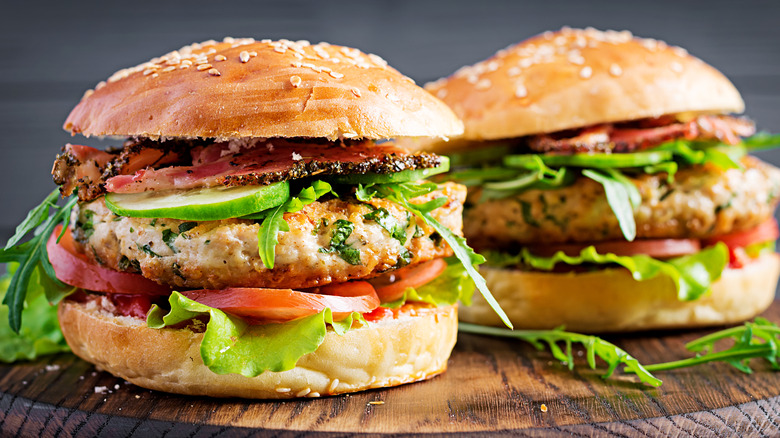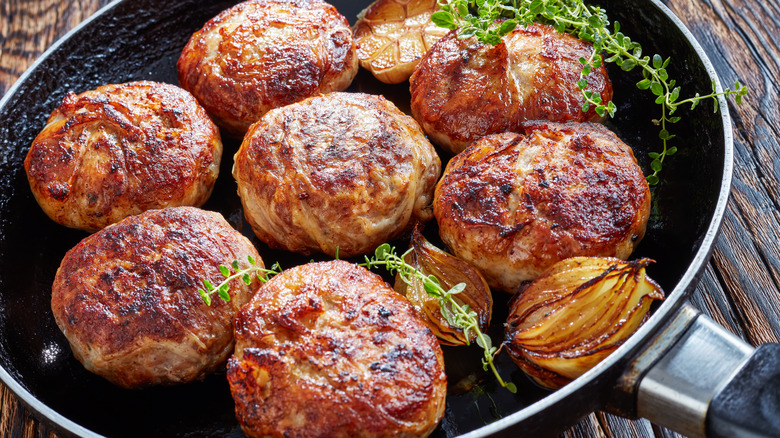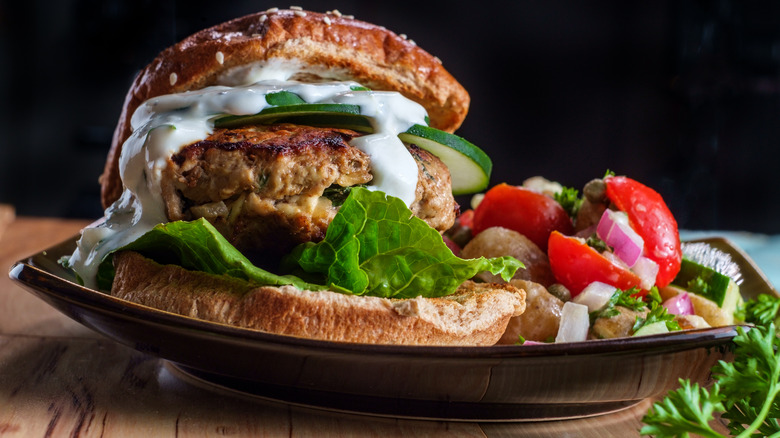For A Perfect Crust On Your Turkey Burgers, Cold-Searing Is The Way To Go
The turkey burger is so misunderstood. Like Brussels sprouts, anchovies, and an uncountable number of other perfectly delicious foods, turkey burgers have suffered from years of bad press, so much so that many people believe they are naturally dry and tasteless. But this isn't true. Turkey burgers can be plump and full of pizzazz — if you know how to properly cook them. A typical blend of ground turkey is about 93% lean and 7% fat, which is not so different from a lean package of ground beef. So why do beef burgers come out charred and juicy, while turkey burgers exit the frying pan dense and bland? The answer is moisture. Ironically, ground turkey possesses a higher percentage of water content than beef, but due to the risk of foodborne illnesses, like salmonella, you have to cook them medium to medium-well.
And this is why turkey burgers are so at risk of becoming shriveled oblong pucks. Thankfully, there are many different techniques that the home cook can use to keep their turkey burgers crispy on the outside, juicy in the middle, and safe to eat. Adding a little baking soda slurry into your meat mixture is one method; dusting your patties with flour is another. But the key to preparing the ultimate turkey burger is all about the cold sear.
How to cook a juicy turkey burger with a crispy outer crust
As mentioned above, there are a few ways to ensure your turkey burgers come out nice and juicy. Besides baking soda and bread crumbs, you can also mix in melted butter, chunks of milk-soaked bread, or diced onions, which release some moisture as they cook. You can also add a squeeze of mayo to your ground turkey to help bind the meat and add some fat. But even with the most precisely constructed turkey burger mixture, at the end of the day, it all comes down to how you cook it. And that's where cold-searing comes into play. Cold searing involves starting your protein — in this case, turkey burgers — in a cold skillet before gradually turning up the heat.
Since ground turkey needs to reach an internal temperature of 165 Fahrenheit to be safe to eat, simply searing it in a hot skillet will result in a burger that is either browned and raw or burnt and dry. Cold searing allows the middle of the burger to cook more thoroughly while the face-down side gets a smoother sear. After one side has a sufficient crust, flip the burger and top the pan with a lid. This effectively steams your patties, gently bringing them up to temperature while keeping them nice and moist. The resulting turkey burgers will be beautifully browned on both sides with a juicy center.
Elevating the taste of your turkey burger
Knowing how to cook a juicy patty is only half of the equation to creating the ultimate turkey burger. The second is adding bold and innovative flavors. Since ground turkey is on the leaner side and a bit muted in flavor, you want to season the meat thoroughly and select the right combination of toppings.
For a Greek turkey burger, sprinkle some oregano and feta cheese into the meat and top the finished burger with a spoonful of tzatziki. You can also go Asian style by adding a few dashes of teriyaki sauce, soy sauce, and sesame oil and topping the finished patty with a mound of lightly pickled shredded carrots, cucumbers, and cilantro. If you're a heat seeker, load your finished turkey burger with chopped celery, shredded lettuce, Buffalo sauce, and a cool cascade of blue cheese dressing.
Mushrooms leach out water when cooked, making them another clever way to moisten your burger patties. Dice some up and add them to your ground turkey mixture before topping the finished patty with a layer of Swiss cheese and bacon strips. And if you really want to push some boundaries, try incorporating a tangy chutney or even an apricot mayonnaise. But whichever turkey burger you choose, cook it with a cold sear.


